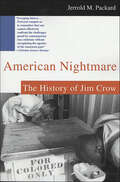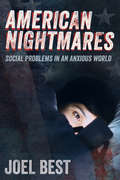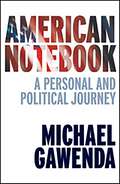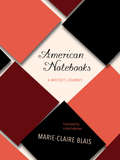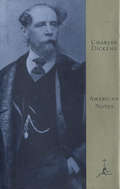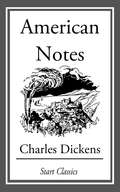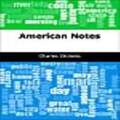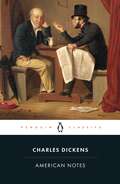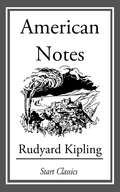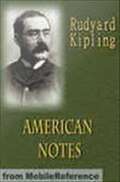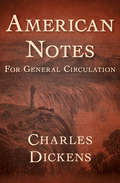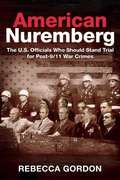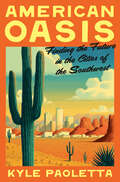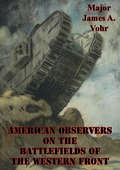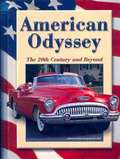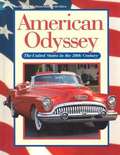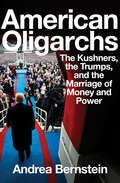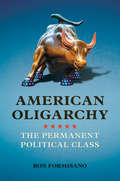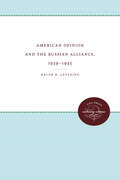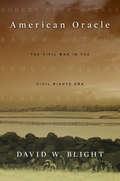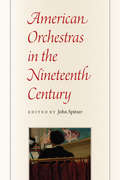- Table View
- List View
American Nightmare: The History of Jim Crow
by Jerrold M. Packard“A very powerful and unsettling story of our nation’s century-long ‘pogrom’ by vengeful white Southerners against their black neighbors.” —The Washington TimesFor a hundred years after the end of the Civil War, a quarter of all Americans lived under a system of legalized segregation called Jim Crow. Together with its rigidly enforced canon of racial “etiquette,” these rules governed nearly every aspect of life—and outlined draconian punishments for infractions.The purpose of Jim Crow was to keep African Americans subjugated at a level as close as possible to their former slave status. Exceeding even South Africa’s notorious apartheid in the humiliation, degradation, and suffering it brought, Jim Crow left scars on the American psyche that are still felt today. American Nightmare examines and explains Jim Crow from its beginnings to its end: how it came into being, how it was lived, how it was justified, and how, at long last, it was overcome only a few short decades ago. Most importantly, this book reveals how a nation founded on principles of equality and freedom came to enact as law a pervasive system of inequality and virtual slavery.Although America has finally consigned Jim Crow to the historical graveyard, Jerrold Packard shows why it is important that this scourge—and an understanding of how it happened—remain alive in the nation’s collective memory.“Sweeping history . . . Packard compels us to remember that one cannot effectively confront the challenges posed by contemporary race relations without recognizing the agonies of the American past.” —The Christian Science Monitor
American Nightmares: Social Problems in an Anxious World
by Joel BestIn an accessible and droll style, well-known sociologist Joel Best shines a light on how we navigate these anxious, insecure social times. While most of us still strive for the American Dream—to graduate from college, own a home, work toward early retirement—recent generations have been told that the next generation will not be able to achieve these goals, that things are getting—or are on the verge of getting—worse. In American Nightmares, Best addresses the apprehension that we face every day as we are bombarded with threats that the social institutions we count on are imperiled. Our schools are failing to teach our kids. Healthcare may soon be harder to obtain. We can’t bank on our retirement plans. And our homes—still the largest chunk of most people’s net worth—may lose much of their value. Our very way of life is being threatened! Or is it? With a steady voice and keen focus, Best examines how a culture develops fears and fantasies and how these visions are created and recreated in every generation. By dismantling current ideas about the future, collective memory, and sociology’s marginalization in the public square, Best sheds light on how social problems—and our anxiety about them—are socially constructed.
American Nonpublic Schools: Patterns of Diversity
by Otto F. KraushaarThis book is about the nonpublic or private schools of America--their history, goals, significance, problems, and prospects. It was undertaken in the belief that these schools, which at their crest educated approximately 6.5 million children in about 19 thousand elementary and secondary schools, constitute an important resource in America's dual system of public and private schooling, a resource which is currently in serious jeopardy.
American Notebook: A Personal and Political Journey
by Michael GawendaOne of the rewards extended to former editors—if they are lucky and get to plan their departure—is that they can choose their next assignment. I had no doubt about what I wanted: to be Washington correspondent for The Age and The Sydney Morning Herald. There was no more important and interesting international story to cover than the United States at the beginning of George W. Bush's second term. The war in Iraq was going badly, and it was not at all clear that the war on terror was being won—or even if there was any agreement that it was, in fact, a war. When veteran journalist Michael Gawenda was posted to the USA as a Washington correspondent in 2005, George W. Bush was beginning his second term, and the war in Iraq was showing signs of becoming a quagmire. Two years later, Bush is a lame duck president and most Americans want their troops out of Iraq. American Notebook is Gawenda's absorbing and insightful account of his American posting. Weaving the personal into the political, Gawenda takes the reader on his journey into a country he has always loved. Beyond daily life in Washington, he visits hurricane-ravaged New Orleans and the God-fearing states of the Midwest. His engaging analysis of politics and current events is interwoven with his reflections on his childhood as a post-war Jewish refugee, growing up in the sixties in a Melbourne steeped in American culture. In light of the increasingly evident failure of efforts in Iraq, he revisits his own controversial decision while editor of The Age newspaper to support the Howard Government's decision in 2003 to join the coalition of the willing. American Notebook is a fascinating discussion of the role of journalism and the nature of public debate about war, politics and current events.
American Notebooks: A Writer's Journey
by Marie-Claire BlaisIt is the spring of 1963. The young Quebec author Marie-Claire Blais, bursting with energy and talent, has just won a coveted Guggenheim fellowship. She chooses Cambridge, Massachusetts, as the place where she will begin her writer's apprenticeship with her mentor, Edmund Wilson. American Notebooks is much more than a fascinating autobiographical account of the intellectual flowering of a great writer. An album of exquisitely drawn literary portraits of companions, intellectuals, writers, musicians, artists and social activists of the period--Edmund and Elena Wilson; Mary Meigs; Maud Maugan; Barbara Deming; Truman Capote; Jacques Hébert, her first Quebec publisher, then senator; and many others--it also introduces many of the real life personalities who have inspired her fictional characters.
American Notes
by Charles DickensWhen Charles Dickens set out for America in 1842 he was the most famous man of his day to travel there - curious about the revolutionary new civilization that had captured the English imagination. His frank and often humorous descriptions cover everything from his comically wretched sea voyage to his sheer astonishment at the magnificence of the Niagara Falls, while he also visited hospitals, prisons and law courts and found them exemplary. But Dickens's opinion of America as a land ruled by money, partly built on slavery, with a corrupt press and unsavoury manners, provoked a hostile reaction on both sides of the Atlantic. American Notes is an illuminating account of a great writer's revelatory encounter with the New World.
American Notes
by Charles DickensCharles Dickens was the most famous of many travelers of his time who journeyed to America, curious about the revolutionary new civilization that had captured the English imagination. His frank, often humorous descriptions in his 1842 account cover everything from his uncomfortable sea voyage to an ecstatic narrative of his visit to Niagara Falls. Yet Dickens is also critical of American society, its preoccupation with money, and reliance on slavery, as well as the rude, unsavory manners of Americans and their corrupt press. Above all, American Notes is a lively chronicle of what was for Dickens an illuminating encounter with the New World.
American Notes
by Charles DickensTrajectory presents classics of world literature with 21st century features! Our original-text editions include the following visual enhancements to foster a deeper understanding of the work: Word Clouds at the start of each chapter highlight important words. Word, sentence, paragraph counts, and reading time help readers and teachers determine chapter complexity. <P> <P> Co-occurrence graphs depict character-to-character interactions as well character to place interactions. Sentiment indexes identify positive and negative trends in mood within each chapter. Frequency graphs help display the impact this book has had on popular culture since its original date of publication. Use Trajectory analytics to deepen comprehension, to provide a focus for discussions and writing assignments, and to engage new readers with some of the greatest stories ever told. "American Notes" by Charles Dickens is an account of Dickens' five month trip across America and Canada in 1842. Read this story to get a humorous and honest portrayal of life in America in the 19th century!
American Notes
by Charles Dickens'Like Shakespeare, Dickens was able to embrace a whole world' John MortimerWhen Charles Dickens set out for America in 1842, he was the most famous man of his day to make the journey, and embarked on his travels with an intense curiosity. His frank descriptions cover everything from his comically wretched sea voyage to his sheer astonishment at Niagara Falls, while he also visited hospitals, prisons and law courts. But Dickens's depiction of America as a land ruled by money, built on slavery, with a corrupt press and unsavoury manners, provoked a hostile reaction on both sides of the Atlantic. American Notes is an illuminating account of a great writer's revelatory encounter with the New World.Edited with an Introduction and Notes by Patricia Ingham
American Notes
by Rudyard KiplingIt is hardly fair to Mr. Kipling to call American Notes first impressions, for one reading them will readily see that the impressions are superficial, little thought being put upon the writing. They seem super-sarcastic, and would lead one to believe that Mr. Kipling is antagonistic to America in every respect. This, however, is not true. These Notes aroused much protest and severe criticism when they appeared in 1891, and are considered so far beneath Mr. Kipling's real work that they have been nearly suppressed and are rarely found in a list of his writings.
American Notes
by Rudyard KiplingThis is what Bret Harte has written of the great city of San Francisco, and for the past fortnight I have been wondering what made him do it. There is neither serenity nor indifference to be found in these parts; and evil would it be for the continents whose wardship were intrusted to so reckless a guardian. Behold me pitched neck-and-crop from twenty days of the high seas into the whirl of California, deprived of any guidance, and left to draw my own conclusions. <P> <P> Protect me from the wrath of an outraged community if these letters be ever read by American eyes San Francisco is a mad city--inhabited for the most part by perfectly insane people, whose women are of a remarkable beauty. .
American Notes: For General Circulation (Modern Library Series #Vol. 1)
by Charles DickensA travelogue detailing Charles Dickens's tour of North America In January of 1842, Charles Dickens and his wife, Kate, traveled from Liverpool to Boston. At the time, Dickens had already attained a tremendous level of literary success and fame, and the author hoped his travels would help him gain insight into the New World that had captivated the English imagination. Over the ensuing 6 months, Dickens explored the East Coast and Great Lakes regions of the United States and Canada, observing life on the opposite side of the Atlantic from a distinctly British viewpoint. By turns humorous, critical, witty, and incisive, this travelogue is a unique and keen look at 19th-century North America. This ebook has been professionally proofread to ensure accuracy and readability on all devices.
American Nuremberg: The U.S. Officials Who Should Stand Trial for Post-9/11 War Crimes
by Rebecca GordonAmerica goes on trial for war crimes in this persuasively argued book from the author of Mainstreaming Torture. In the aftermath of 9/11, the Bush administration initiated a war on terror that systematically violated international law. In the name of national security, the United States government established secret detention centers (aka “black sites”) and carried out torture, extraordinary rendition, drone assassinations, and massive surveillance of its own citizens. Though there is overwhelming evidence of these human rights violations, no action has been taken to pursue justice for the victims. No high US official has been charged for enacting these policies, considered by legal experts around the world to be war crimes. Between 1945 and 1949, the United States and its allies put nearly two hundred Nazi war criminals on trial, a towering political achievement that established the legitimacy of international law. Philosopher and ethicist Rebecca Gordon argues that America must now either apply the same principles to its own officials or risk undoing its legacy as leader of the free world. In American Nuremberg, she not only makes a compelling case for the prosecution, but also lays out the legal groundwork that would make such a tribunal possible in our time.
American Nursing: A History of Knowledge, Authority, and the Meaning of Work
by Patricia D'AntonioFirst Place, History and Public Policy, 2010 American Journal of Nursing Book of the Year AwardsThis new interpretation of the history of nursing in the United States captures the many ways women reframed the most traditional of all gender expectations—that of caring for the sick—to create new possibilities for themselves, to renegotiate the terms of some of their life experiences, and to reshape their own sense of worth and power. For much of modern U.S. history, nursing was informal, often uncompensated, and almost wholly the province of female family and community members. This began to change at the end of the nineteenth century when the prospect of formal training opened for women doors that had been previously closed. Nurses became respected professionals, and becoming a formally trained nurse granted women a range of new social choices and opportunities that eventually translated into economic mobility and stability. Patricia D'Antonio looks closely at this history—using a new analytic framework and a rich trove of archival sources—and finds complex, multiple meanings in the individual choices of women who elected a nursing career. New relationships and social and professional options empowered nurses in constructing consequential lives, supporting their families, and participating both in their communities and in the health care system. Narrating the experiences of nurses, D'Antonio captures the possibilities, power, and problems inherent in the different ways women defined their work and lived their lives. Scholars in the history of medicine, nursing, and public policy, those interested in the intersections of identity, work, gender, education, and race, and nurses will find this a provocative book.
American Oasis: Finding the Future in the Cities of the Southwest
by Kyle PaolettaAn expansive and revelatory historical exploration of the multicultural, water-seeking, land-destroying settlers of the most arid corner of North America, arguing that in order to know where the United States is going in the era of mass migration and climate crisis we must understand where the Southwest has already beenAlbuquerque. Phoenix. Tucson. El Paso. Las Vegas. Iconic American cities surrounded by desert and rust. Teeming metropolises that seem to exist independently of the seemingly inhospitable and arid landscape that surrounds them, belying the rich insight they offer into American stories of migration, industry, bloodshed, and rebirth. Charting a geographic path through America's largest and hottest deserts, acclaimed journalist Kyle Paoletta maps the past and future of these cities, and the many other settlements from rural town to urban sprawl that make up the region that has come to be called &“the American Southwest.&” Weaving together the stories of immigrants and indigenous populations, American Oasis pulls back the layers of settlement, sediment, habit, and effect that successive empires have left on the region, from the Athapascan, Diné, Tewa, Apache, and Comanche, to the Spanish, Mexican, and, finally, American. As Paoletta&’s journey into the Southwest&’s history becomes inextricably linked to an exploration of its dependency on water, he begins to ask: where, ultimately, will cities like Las Vegas and Phoenix find themselves once the Colorado River and its branches dry up? Richly reported and sweeping in its history, American Oasis is the story of what one iconic region&’s past can tell us about our shared environmental and cultural future.
American Observers On The Battlefields Of The Western Front
by Major James A. Vohr USMCAlthough during World War I the United States employed observers on the battlefields of the Western Front, the information they provided lacked the substance and conclusions required to evolve the tactical doctrine of the American Expeditionary Forces (AEF). In initial engagements, the AEF was largely forced to rely, with predictable negative outcome, upon outdated concepts founded largely upon the prejudices of the Army's leadership.In August of 1914 the United States Army and Marine Corps demonstrated strong foresight, considering the isolationist perspective of the nation, in detailing officers to the battlefields of Europe. These officers were given little guidance, but their mission was clearly to report on military actions and developments in what was becoming the largest struggle in history. A significant military development of World War I noted by the U.S. was the advance of offensive infantry tactics to cope effectively with the characteristics and lethality of the modern battlefield.The United States, with a two and one-half year opportunity to observe tactics prior to the engagement of the AEF, arguably should have benefited from the experience of others. However, this was not the case. The AEF in its initial engagements, performed much as its European counterparts did at the onset of the war. Eventually the AEF performance improved, but only as U.S. soldiers and Marines gained personal battlefield experience.
American Odyssey: The 20th Century and Beyond
by Gary B. NashThe book covers relationships, interprets evidence, and connects the present to the past--that's what history is all about.
American Odyssey: The United States in the 20th Century
by Gary B. NashA history of the United States in the twentieth century, featuring sociological and cultural events, as well as strictly historical, and using many pertinent literary excerpts.
American Odyssey: The United States in the 20th Century
by Gary B. NashA history of the United States in the twentieth century, featuring sociological and cultural events, as well as strictly historical, and using many pertinent literary excerpts.
American Odyssey: The United States in the Twentieth Century
by Gary B. NashA history of the United States in the twentieth century, featuring sociological and cultural events, as well as strictly historical, and using many pertinent literary excerpts.
American Oligarchs: The Kushners, The Trumps, And The Marriage Of Money And Power
by Andrea BernsteinA multigenerational saga of two families, who rose from immigrant roots to the pinnacle of wealth and power, that tracks the unraveling of American democracy. <P><P>In American Oligarchs, award-winning investigative journalist Andrea Bernstein tells the story of the Trump and Kushner families like never before. Their journey to the White House is a story of survival and loss, crime and betrayal, that stretches from the Klondike Gold Rush, through Nazi-occupied Poland and across the American Century, to our new gilded age. In building and maintaining their dynastic wealth, these families came to embody the rising nationalism and inequality that has pushed the United States to the brink of oligarchy. <P><P>Building on her landmark reporting for the acclaimed podcast Trump, Inc. and The New Yorker, Bernstein’s painstaking detective work brings to light new information about the families’ arrival as immigrants to America, their paths to success, and the business and personal lives of the president and his closest family members. <P><P>Bernstein traces how the two families ruthlessly harnessed New York and New Jersey machine politics to gain valuable tax breaks and grew rich on federal programs that bolstered the middle class. She shows how the Trump Organization, denied credit by American banks, turned to shady international capital. She reveals astonishing new details about Charles Kushner’s attempts to ensnare his brother-in-law with a prostitute and explores how Jared Kushner and his father used a venerable New York newspaper to bolster their business empire. <P><P>Drawing on more than two hundred interviews and more than one hundred thousand pages of documents, many previously unseen or long forgotten, Bernstein shows how the Trumps and the Kushners repeatedly broke rules and then leveraged secrecy, intimidation, and prosecutorial and judicial power to avoid legal consequences. <P><P>The result is a compelling narrative that details how the Trump and Kushner dynasties encouraged and profited from a system of corruption, dark money, and influence trading, and that reveals the historical turning points and decisions—on taxation, regulation, white-collar crime, and campaign finance laws—that have brought us to where we are today. <P><P><b>A New York Times Bestseller</b>
American Oligarchy: The Permanent Political Class
by Ron FormisanoA permanent political class has emerged on a scale unprecedented in our nation 's history. Its self-dealing, nepotism, and corruption contribute to rising inequality. Its reach extends from the governing elite throughout nongovernmental institutions. Aside from constituting an oligarchy of prestige and power, it enables the creation of an aristocracy of massive inherited wealth that is accumulating immense political power. In a muckraking tour de force reminiscent of Lincoln Steffens, Upton Sinclair, and C. Wright Mills, American Oligarchy demonstrates the way the corrupt culture of the permanent political class extends down to the state and local level. Ron Formisano breaks down the ways this class creates economic inequality and how its own endemic corruption infects our entire society. Formisano delves into the work of not just politicians but lobbyists, consultants, appointed bureaucrats, pollsters, celebrity journalists, behind-the-scenes billionaires, and others. Their shameless pursuit of wealth and self-aggrandizement, often at taxpayer expense, rewards channeling the flow of income and wealth to elites. That inequality in turn has choked off social mobility and made a joke of meritocracy. As Formisano shows, these forces respond to the oligarchy 's power and compete to bask in the presence of the .01 percent. They also exacerbate the dangerous instability of an American democracy divided between extreme wealth and extreme poverty.
American Opinion and the Russian Alliance, 1939-1945
by Ralph B. LeveringIn this analysis of the years of greatest American friendship with the Soviet Union, Levering comes to two conclusions. First, cosmopolitan, educated Americans of all classes were much more likely to change their negative attitudes of 1939 to positive ones by 1943 than were the provincial and poorly educated. Second, governmental leaders and the media, whether conservative or liberal, did not prepare the public for the probable realities of postwar international politics.Originally published in 1976.A UNC Press Enduring Edition -- UNC Press Enduring Editions use the latest in digital technology to make available again books from our distinguished backlist that were previously out of print. These editions are published unaltered from the original, and are presented in affordable paperback formats, bringing readers both historical and cultural value.
American Oracle: The Civil War in the Civil Rights Era
by David W. Blight“The ghosts of the Civil War never leave us, as David Blight knows perhaps better than anyone, and in this superb book he masterfully unites two distant but inextricably bound events.”―Ken Burns Standing on the steps of the Lincoln Memorial on August 28, 1963, a century after the signing of the Emancipation Proclamation, Martin Luther King, Jr., declared, “One hundred years later, the Negro still is not free.” He delivered this speech just three years after the Virginia Civil War Commission published a guide proclaiming that “the Centennial is no time for finding fault or placing blame or fighting the issues all over again.” David Blight takes his readers back to the centennial celebration to determine how Americans then made sense of the suffering, loss, and liberation that had wracked the United States a century earlier. Amid cold war politics and civil rights protest, four of America’s most incisive writers explored the gulf between remembrance and reality. Robert Penn Warren, the southern-reared poet-novelist who recanted his support of segregation; Bruce Catton, the journalist and U.S. Navy officer who became a popular Civil War historian; Edmund Wilson, the century’s preeminent literary critic; and James Baldwin, the searing African-American essayist and activist—each exposed America’s triumphalist memory of the war. And each, in his own way, demanded a reckoning with the tragic consequences it spawned. Blight illuminates not only mid-twentieth-century America’s sense of itself but also the dynamic, ever-changing nature of Civil War memory. On the eve of the 150th anniversary of the war, we have an invaluable perspective on how this conflict continues to shape the country’s political debates, national identity, and sense of purpose.
American Orchestras in the Nineteenth Century
by John SpitzerStudies of concert life in nineteenth-century America have generally been limited to large orchestras and the programs we are familiar with today. But as this book reveals, audiences of that era enjoyed far more diverse musical experiences than this focus would suggest. To hear an orchestra, people were more likely to head to a beer garden, restaurant, or summer resort than to a concert hall. And what they heard weren't just symphonic works--programs also included opera excerpts and arrangements, instrumental showpieces, comic numbers, and medleys of patriotic tunes. This book brings together musicologists and historians to investigate the many orchestras and programs that developed in nineteenth-century America. In addition to reflecting on the music that orchestras played and the socioeconomic aspects of building and maintaining orchestras, the book considers a wide range of topics, including audiences, entrepreneurs, concert arrangements, tours, and musicians' unions. The authors also show that the period saw a massive influx of immigrant performers, the increasing ability of orchestras to travel across the nation, and the rising influence of women as listeners, patrons, and players. Painting a rich and detailed picture of nineteenth-century concert life, this collection will greatly broaden our understanding of America's musical history.
